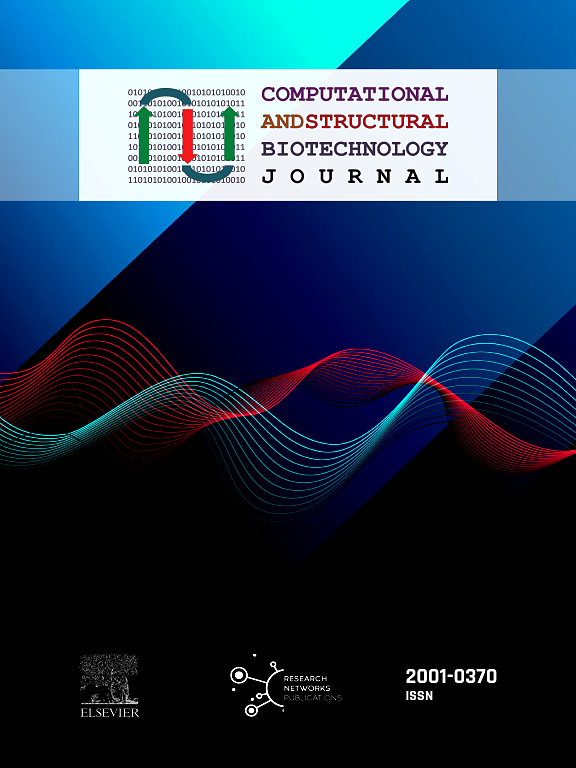Differential prolyl hydroxylation by six Physcomitrella prolyl-4 hydroxylases
IF 4.1
2区 生物学
Q2 BIOCHEMISTRY & MOLECULAR BIOLOGY
Computational and structural biotechnology journal
Pub Date : 2024-06-13
DOI:10.1016/j.csbj.2024.06.014
引用次数: 0
Abstract
Hydroxylation of prolines to 4-trans-hydroxyproline (Hyp) is mediated by prolyl-4 hydroxylases (P4Hs). In plants, Hyps occur in Hydroxyproline-rich glycoproteins (HRGPs), and are frequently -glycosylated. While both modifications are important, for cell wall stability, they are undesired in plant-made pharmaceuticals. Sequence motifs for prolyl-hydroxylation were proposed but did not include data from mosses, such as Physcomitrella. We identified six moss P4Hs by phylogenetic reconstruction. Our analysis of 73 Hyps in 24 secretory proteins from multiple mass spectrometry datasets revealed that prolines near other prolines, alanine, serine, threonine and valine were preferentially hydroxylated. About 95 % of Hyps were predictable with combined established methods. In our data, AOV was the most frequent pattern. A combination of 443 AlphaFold models and MS data with 3000 prolines found Hyps mainly on protein surfaces in disordered regions. Moss-produced human erythropoietin (EPO) exhibited -glycosylation with arabinose chains on two Hyps. This modification was significantly reduced in a knock-out (KO) Physcomitrella mutant. Quantitative proteomics with different mutants revealed specific changes in protein amounts, and a modified prolyl-hydroxylation pattern, suggesting a differential function of the Physcomitrella P4Hs. Quantitative RT-PCR revealed a differential effect of single KOs on the expression of the other five genes, suggesting a partial compensation of the mutation. AlphaFold-Multimer models for Physcomitrella P4H1 and its target EPO peptide superposed with the crystal structure of Chlamydomonas P4H1 suggested significant amino acids in the active centre of the enzyme and revealed differences between P4H1 and the other Physcomitrella P4Hs.

六种伞形植物脯氨酰-4羟化酶的脯氨酰羟化作用不同
脯氨酸羟化成 4-反式羟脯氨酸(Hyp)是由脯氨酰-4 羟化酶(P4Hs)介导的。在植物中,Hyps 存在于富含羟脯氨酸的糖蛋白(HRGPs)中,并经常进行糖基化。虽然这两种修饰对细胞壁的稳定性都很重要,但在植物制成的药物中却不受欢迎。有人提出了脯氨酰羟基化的序列模式,但没有包括来自苔藓(如Physcomitrella)的数据。我们通过系统发育重建确定了六种苔藓 P4Hs。我们对多个质谱数据集中 24 种分泌蛋白中的 73 个 Hyps 进行了分析,发现靠近其他脯氨酸、丙氨酸、丝氨酸、苏氨酸和缬氨酸的脯氨酸优先羟化。综合已有的方法,大约 95% 的 Hyps 是可以预测的。在我们的数据中,AOV 是最常见的模式。结合 443 个 AlphaFold 模型和 3000 个脯氨酸的 MS 数据发现,Hyps 主要出现在蛋白质表面的无序区域。苔藓生产的人类促红细胞生成素(EPO)在两个 Hyps 上表现出阿拉伯糖链的-糖基化。这种修饰在基因敲除(KO) Physcomitrella 突变体中明显减少。不同突变体的定量蛋白质组学显示了蛋白质数量的特定变化,以及经过修饰的脯氨酰-羟基化模式,这表明了 Physcomitrella P4Hs 的不同功能。定量 RT-PCR 发现,单个 KO 对其他五个基因的表达有不同影响,这表明突变具有部分补偿作用。Physcomitrella P4H1 及其目标 EPO 多肽的 AlphaFold-Multimer 模型与衣藻 P4H1 的晶体结构叠加,显示了该酶活性中心的重要氨基酸,并揭示了 P4H1 与其他 Physcomitrella P4Hs 之间的差异。
本文章由计算机程序翻译,如有差异,请以英文原文为准。
求助全文
约1分钟内获得全文
求助全文
来源期刊

Computational and structural biotechnology journal
Biochemistry, Genetics and Molecular Biology-Biophysics
CiteScore
9.30
自引率
3.30%
发文量
540
审稿时长
6 weeks
期刊介绍:
Computational and Structural Biotechnology Journal (CSBJ) is an online gold open access journal publishing research articles and reviews after full peer review. All articles are published, without barriers to access, immediately upon acceptance. The journal places a strong emphasis on functional and mechanistic understanding of how molecular components in a biological process work together through the application of computational methods. Structural data may provide such insights, but they are not a pre-requisite for publication in the journal. Specific areas of interest include, but are not limited to:
Structure and function of proteins, nucleic acids and other macromolecules
Structure and function of multi-component complexes
Protein folding, processing and degradation
Enzymology
Computational and structural studies of plant systems
Microbial Informatics
Genomics
Proteomics
Metabolomics
Algorithms and Hypothesis in Bioinformatics
Mathematical and Theoretical Biology
Computational Chemistry and Drug Discovery
Microscopy and Molecular Imaging
Nanotechnology
Systems and Synthetic Biology
 求助内容:
求助内容: 应助结果提醒方式:
应助结果提醒方式:


